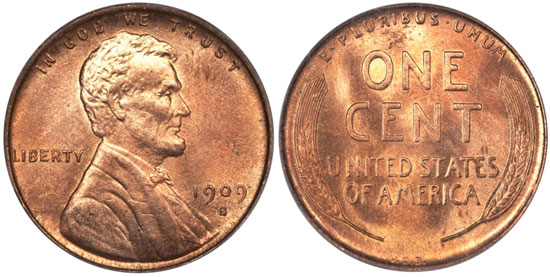Background and History
The 1909-S VDB Lincoln Cent (Buy on eBay) is the famous key date coin from the inaugural year of the Lincoln Cent series. This rarity was created by the removal of the designer Victor D. Brenner’s initials “V.D.B.” after as few as five working days at the San Francisco Mint. The coin has been popular since the public became aware of it, due to its perceived scarcity and its widely recounted back story.

The Lincoln Cent was the replacement for the Indian Head Cent, which had been introduced 50 years earlier in 1859. The new series was released in 1909 to coincide with the 100th anniversary of the birth of Abraham Lincoln. The likeness of the 16th President was designed by Victor D. Brenner, a Lithuanian immigrant who had created a bronze plaque in 1907 featuring a bust of Lincoln. President Theodore Roosevelt, who had sat for Brenner for a Panama Canal commemorative medal, liked the work of the artist so much that he chose the image of Lincoln from the plaque as the design for the new cent. Notably, this would represent the first use of a Presidential portrait on a circulating United States coin.
The reverse of the coin, which would also be designed by Brenner, featured two wheat stalks along with the required inscriptions. The designer’s initials “V.D.B.” were placed on the lower reverse in capital letters. The design would be struck at the Philadelphia and San Francisco Mint for a very short period before it was decided that the designer’s initials were too prominent and should be removed. While it is often mentioned in numismatic literature that the public opposed the prominent placement of the designer’s initials on the coin, it has also been suggested that Chief Engraver Charles E. Barber opposed them strongly, leading to their removal.
Coin Mintage
Production for the 1909-S VDB Lincoln Cent was halted at just 484,000 pieces. Virtually the entire amount was placed into circulation, although many were soon retracted when people recognized the low mintage and potential value. While the mintage of the coin is not an extremely low number in the absolute sense, survivors are popular and trade for a strong premium above other Lincoln Cents of the same period. This issue has long been considered one of the most famous and popular within all of American coinage.
As a result of the short production run and low mintage, virtually all examples of this coin are early die states with sharp strikes and excellent eye-appeal. Obviously, exceptions exist, but finding a problem-free 1909-S VDB Lincoln Cent is typically not too difficult. Thanks to early hoarding and later retraction from circulation, virtually all grades are available, from well-circulated up to gem mint state with original red color.
It is difficult to estimate the total number of survivors of this issue, as hoards or accumulations might still exist, but a high proportion of the original mintage has likely survived. Some estimates put the figure as high as 400,000 pieces, although this number appears to be a bit on the high side. It is safe to say that at least 150,000 pieces survive across all grades.
Finest Known and Values
The finest known 1909-S VDB Lincoln Cents include about a dozen pieces graded MS-67 RD by PCGS and two pieces graded at the same level by NGC. These are periodically sold at auction, with a recent example graded PCGS MS-67 RD selling for $50,400 in 2019. Across both grading services approximately 300 pieces have graded MS-66 RD, followed by more than 1,000 pieces graded MS-65 RD. Auction prices are typically around $9,000 for an MS-66 RD and around $4,000 for an MS-65 RD.
In Red-Brown, often representing an excellent value, a single coin has been graded MS-67 RB by PCGS. Across both PCGS and NGC, more than 100 pieces have been graded MS-66 RB, followed by about 1,500 pieces graded MS-65 RB. Prices are typically around $5,000 for coins graded MS-66 RB and $3,000 for coins graded MS-65 RB.
With the coloration designated as Brown, a single example has been graded MS-67 BN by PCGS followed by about two dozen examples graded MS-66 BN by each of the services. Pricing for these coins is typically slightly lower than the prices realized for coins with Red-Brown coloration.

